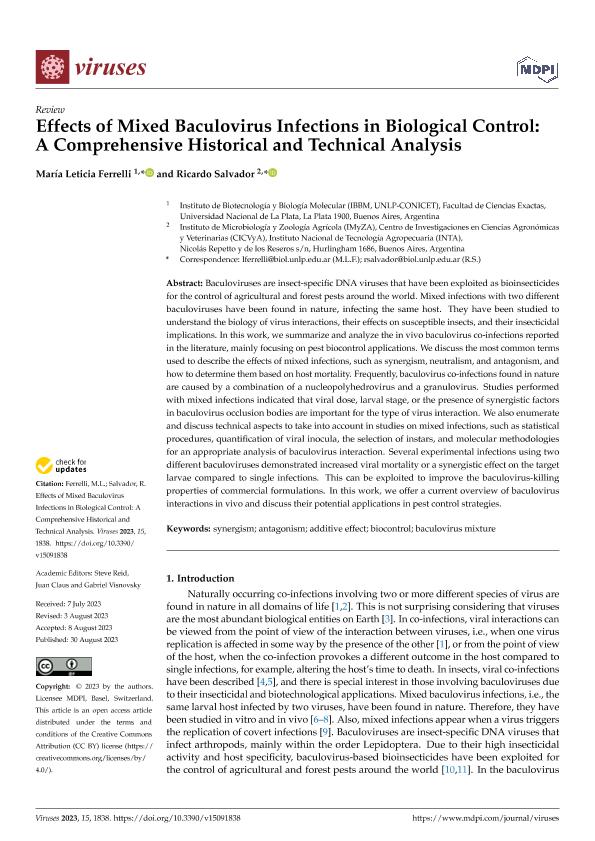Mostrar el registro sencillo del ítem
dc.contributor.author
Ferrelli, Maria Leticia

dc.contributor.author
Salvador, Ricardo

dc.date.available
2024-03-12T11:36:55Z
dc.date.issued
2023-08
dc.identifier.citation
Ferrelli, Maria Leticia; Salvador, Ricardo; Effects of Mixed Baculovirus Infections in Biological Control: A Comprehensive Historical and Technical Analysis; MDPI; Viruses; 15; 9; 8-2023; 1-24
dc.identifier.issn
1999-4915
dc.identifier.uri
http://hdl.handle.net/11336/230141
dc.description.abstract
Baculoviruses are insect-specific DNA viruses that have been exploited as bioinsecticides for the control of agricultural and forest pests around the world. Mixed infections with two different baculoviruses have been found in nature, infecting the same host. They have been studied to understand the biology of virus interactions, their effects on susceptible insects, and their insecticidal implications. In this work, we summarize and analyze the in vivo baculovirus co-infections reported in the literature, mainly focusing on pest biocontrol applications. We discuss the most common terms used to describe the effects of mixed infections, such as synergism, neutralism, and antagonism, and how to determine them based on host mortality. Frequently, baculovirus co-infections found in nature are caused by a combination of a nucleopolyhedrovirus and a granulovirus. Studies performed with mixed infections indicated that viral dose, larval stage, or the presence of synergistic factors in baculovirus occlusion bodies are important for the type of virus interaction. We also enumerate and discuss technical aspects to take into account in studies on mixed infections, such as statistical procedures, quantification of viral inocula, the selection of instars, and molecular methodologies for an appropriate analysis of baculovirus interaction. Several experimental infections using two different baculoviruses demonstrated increased viral mortality or a synergistic effect on the target larvae compared to single infections. This can be exploited to improve the baculovirus-killing properties of commercial formulations. In this work, we offer a current overview of baculovirus interactions in vivo and discuss their potential applications in pest control strategies.
dc.format
application/pdf
dc.language.iso
eng
dc.publisher
MDPI
dc.rights
info:eu-repo/semantics/openAccess
dc.rights.uri
https://creativecommons.org/licenses/by/2.5/ar/
dc.subject
SYNERGISM
dc.subject
ANTAGONISM
dc.subject
ADDITIVE EFFECT
dc.subject
BIOCONTROL
dc.subject
BACULOVIRUS MIXTURE
dc.subject.classification
Virología

dc.subject.classification
Ciencias Biológicas

dc.subject.classification
CIENCIAS NATURALES Y EXACTAS

dc.title
Effects of Mixed Baculovirus Infections in Biological Control: A Comprehensive Historical and Technical Analysis
dc.type
info:eu-repo/semantics/article
dc.type
info:ar-repo/semantics/artículo
dc.type
info:eu-repo/semantics/publishedVersion
dc.date.updated
2024-03-11T11:52:11Z
dc.journal.volume
15
dc.journal.number
9
dc.journal.pagination
1-24
dc.journal.pais
Suiza

dc.description.fil
Fil: Ferrelli, Maria Leticia. Consejo Nacional de Investigaciones Científicas y Técnicas. Centro Científico Tecnológico Conicet - La Plata. Instituto de Biotecnología y Biología Molecular. Universidad Nacional de La Plata. Facultad de Ciencias Exactas. Instituto de Biotecnología y Biología Molecular; Argentina
dc.description.fil
Fil: Salvador, Ricardo. Instituto Nacional de Tecnología Agropecuaria. Centro de Investigación en Ciencias Veterinarias y Agronómicas. Instituto de Microbiología y Zoología Agrícola; Argentina
dc.journal.title
Viruses
dc.relation.alternativeid
info:eu-repo/semantics/altIdentifier/url/https://www.mdpi.com/1999-4915/15/9/1838
dc.relation.alternativeid
info:eu-repo/semantics/altIdentifier/doi/http://dx.doi.org/10.3390/v15091838
Archivos asociados
